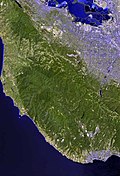| Guadalupe Valley Creek Cañada de Guadalupe [1] | |
|---|---|
 | |
| Location | |
| Country | United States |
| State | California |
| Region | San Mateo County |
| City | Brisbane |
| Physical characteristics | |
| Source | San Bruno Mountain |
| • location | San Mateo County, California |
| • coordinates | 37°41′37″N122°25′36″W / 37.693737°N 122.4266302°W [2] |
| • elevation | 980 ft (300 m) |
| Mouth | Brisbane Lagoon |
• location | Brisbane, California |
• coordinates | 37°41′14″N122°23′54″W / 37.68716°N 122.39847°W [2] |
• elevation | 20 ft (6.1 m) [2] |
| Basin features | |
| Tributaries | |
| • left | Wax Myrtle Ravine |
| • right | Devil's Arroyo, Owl Canyon, Buckeye Canyon |
Guadalupe Creek or Guadalupe Valley Creek is a short eastward-flowing stream whose watershed originates just east of the highest peak of San Bruno Mountain in San Mateo County, California, United States. It courses through San Bruno Mountain State and County Park and Brisbane before entering the Brisbane Lagoon.

